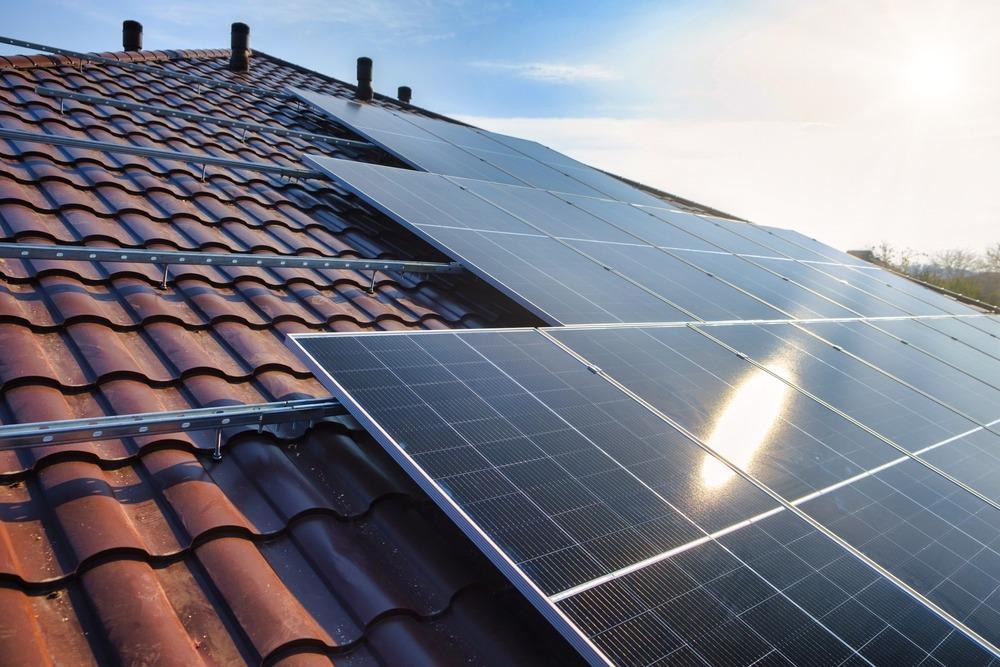 By Surbhi JainReviewed by Susha Cheriyedath, M.Sc.Jun 16 2022
By Surbhi JainReviewed by Susha Cheriyedath, M.Sc.Jun 16 2022In an article recently published in the journal ACS Applied Energy Materials, researchers discussed the development of p-i-n perovskite solar cells on steel substrates.

Study: p–i–n Perovskite Solar Cells on Steel Substrates. Image Credit: AlyoshinE/Shutterstock.com
Background
When covered with photovoltaic modules, the enormous, frequently underused opaque sections of warehouse rooftops and facades, logistic hubs, and industrial halls can be utilized to generate sustainable electricity production. Coated steel is frequently used as the building skin in these industrial structures.
As a result, considering steel as a substrate for solar cell fabrication seems intriguing. Metal-halide perovskite solar cells (PSCs) can potentially provide a solution for building-integrated photovoltaics when produced directly on steel due to their low cost, high efficiency, light weight, and compatibility with a range of substrates.
For substrate-configuration PSCs placed on metal substrates, obtaining high power conversion efficiencies (PCEs) is difficult. The majority of PSCs produced on metal foils have an n-i-p cell layout, and there are few reports for p-i-n stacks. The p-i-n substrate-configuration is now widely used for wide-bandgap PSCs in two-terminal monolithic tandem sun cells having a crystalline Si bottom cell. Furthermore, many charge-selective connections for p-i-n PSCs have been identified that enable efficient, energetic alignment with the perovskite active layer and minimal resistive losses.
About the Study
In this study, the authors discussed the development of an effective substrate-configuration pin metal-halide PSC on a polymer-coated steel substrate. As a hole-selective contact, the optimized cell used a Ti bottom electrode coated with a thin indium tin oxide (ITO) interlayer and a self-assembled [2-(9H-carbazol-9-yl)ethyl]phosphonic acid monolayer.
The absorber layer was made of triple-cation perovskite. An electron-selective contact was created using thermally evaporated C60 and atomic layer deposited SnO2 layers. The cells had an anti-reflective MgF2 coating on the top electrode, which was made of ITO.
The team established an effective substrate-configuration p-i-n PSC on steel coated with a polyamide-imide (PAI) planarization layer. The insulating layer was the planarization layer. A hole-collecting electrode was an opaque titanium electrode coated with a thin sputtered ITO layer that allowed binding of the phosphonic acid anchoring groups of the 2PACz monolayer. A C60 layer was combined with a SnO2 buffer layer for electron collecting to prevent damage to the underlying stack during the sputter deposition of the ITO top electrode.
The researchers used optical modeling for the analysis of parasitic optical losses. To facilitate the binding of 2PACz as a self-assembled hole-selective monolayer, the substrate-configuration cell was constructed on a Ti bottom electrode coated with a thin ITO interlayer.
Observations
With an open-circuit voltage (Voc) of 1.11 V, a short-circuit current density (Jsc) of 19.8 mA cm-2, and a fill factor (FF) of 0.72, the substrate cell on glass (cell A) achieved 15.8% PCE. The ideality factor n = 2.10 for the substrate cell was larger than n = 1.69 for the superstrate cell, which implied that trap-assisted recombination dominated charge recombination dynamics in an open circuit. The highest photocurrent for the substrate cell was 20.4 mA cm-2, whereas the maximum photocurrent for the superstrate cell was 21.7 mA cm-2. The AM1.5G-averaged internal quantum efficiency (IQE) was 93% for the substrate cell and 95% for the superstrate cell.
The optimized cell, which was constructed on a polymer-coated steel substrate, achieved a PCE of 16.5%, comparable to the 18.4% efficiency of a pin reference superstrate-configuration cell with a similar stack design. According to optical simulations, the remaining optical losses were virtually evenly distributed between light absorption by the ITO top electrode, the Ti bottom electrode, the C60 layer, and the reflection from the MgF2 coating. However, the fill factor suffered the most damage as a result of the top ITO electrode's increased sheet resistance. On steel substrates, optimized devices achieved a 16.5% efficiency.
The best cell constructed on a polymer-coated Ni-plated battery steel substrate attained a PCE of 16.5%. The main loss was in the FF because of the high sheet resistance of the ITO top electrode when compared to the similar superstrate p-i-n cell on glass with a PCE of 18.4%. The total optical loss of 4.4 mA cm-2 of the substrate cell was just slightly higher than that of a conventional superstrate p-i-n reference cell. The difference was primarily due to the C60 ETL's and the Ti bottom electrode's greater parasitic absorption.
Conclusions
In conclusion, this study elucidated the development of an efficient p-i-n PSC by using a steel substrate coated with a polymer planarization layer and a transparent top electrode.
The authors believe that reducing optical losses in the ETL, improving the reflection of the bottom electrode, and utilizing a less resistive transparent top contact can all be used to improve the PCE of substrate-configuration cells.
More from AZoM: What is Glow Discharge Optical Emission Spectrometry
Disclaimer: The views expressed here are those of the author expressed in their private capacity and do not necessarily represent the views of AZoM.com Limited T/A AZoNetwork the owner and operator of this website. This disclaimer forms part of the Terms and conditions of use of this website.
Source:
Feleki, B. T., Bouwer, R. K. M., Zardetto, V., et al. p–i–n Perovskite Solar Cells on Steel Substrates. ACS Applied Energy Materials (2022). https://pubs.acs.org/doi/10.1021/acsaem.2c00291